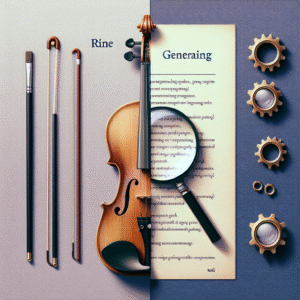Have you ever wondered how chatbots have evolved over the years and what amazing innovations lie ahead? I find it fascinating how these digital assistants have transformed the way we communicate, conduct business, and solve problems.
Understanding Chatbots
Chatbots are essentially computer programs designed to simulate human conversation, either through text or voice interactions. They use artificial intelligence (AI) and natural language processing (NLP) technologies to understand and respond to user inquiries. My first encounter with a chatbot was a simple one, assisting with customer service inquiries online. Back then, the technology was fairly basic, but I could see the potential.
The Evolution of Chatbots
The journey of chatbot technology is quite remarkable. It all began in the 1960s with ELIZA, an early natural language processing program that could mimic human conversations with users. As I learned about this history, I found it interesting how long it took for chatbots to gain mainstream acceptance.
In the 1990s, we saw a significant advancement with the introduction of more sophisticated algorithms, but it wasn’t until the rise of AI and machine learning in the 2000s that chatbots really started to shine. I remember being amazed when I first interacted with a chatbot that not only understood context but could also maintain a conversation over multiple exchanges.
Key Milestones in Chatbot Development
| Year | Milestone |
|---|---|
| 1966 | ELIZA launched |
| 1995 | A.L.I.C.E. (Artificial Linguistic Internet Computer Entity) created |
| 2010 | Siri introduced by Apple |
| 2013 | Facebook Messenger chatbot launched |
| 2020 | OpenAI releases GPT-3 |
When I look back at these milestones, it’s clear they represent massive leaps in what chatbots can do. Siri, for instance, opened up new possibilities for voice-activated assistance in everyday life.
Innovations Shaping Modern Chatbots
Today’s chatbots are far more advanced and capable than their earlier counterparts. They can handle complex queries, engage in meaningful conversations, and even learn from interactions. It’s been exciting to follow the innovations that shape their development.
Natural Language Processing (NLP)
One of the most significant innovations in chatbot technology is the improvement in natural language processing. NLP allows chatbots to understand and interpret human language in a more sophisticated way.
It’s fascinating to see how they can now recognize context, slang, and even regional dialects. I remember a time when chatbots provided responses that felt robotic, but now they can generate replies that feel much more human-like.
Machine Learning
Machine learning has been a game-changer in the chatbot space. Through algorithms that allow chatbots to improve their performance over time, they can offer increasingly relevant responses based on historical interactions.
I find it incredible how these systems can analyze past conversations to better serve users in the future. It’s almost like having a personal assistant that truly understands my preferences and needs.
Integration with Advanced AI Models
The integration of advanced AI models like GPT-3 has skyrocketed the capabilities of chatbots. These models can parse significant amounts of information, producing responses that are not just accurate but also contextually rich.
I love how these advanced chatbots can engage in more nuanced discussions, whether providing customer support or assisting in content creation.
Multimodal Capabilities
An exciting trend in chatbot innovation is their multimodal capabilities. This means that chatbots can handle not just text but also images, audio, and even video.
I’ve experienced this first-hand when using chatbots that allow me to send images for better understanding or receive video tutorials in response to queries. This capability truly enhances the overall user experience.
Use Cases of Chatbots
Chatbots are no longer confined to simple customer service tasks. They’ve branched out into various industries and applications.
Customer Service
One of the most common applications of chatbots is in customer service. Businesses leverage them to provide timely responses to customer inquiries, thereby improving satisfaction and efficiency.
With 24/7 availability, I appreciate how these chatbots can assist me with issues at any time without keeping me waiting for human intervention.
E-commerce
In the world of e-commerce, chatbots streamline the shopping experience. They can assist with product recommendations, processing orders, and even handling returns.
When I shop online, I find it incredibly convenient to ask a chatbot for product suggestions based on my preferences, turning my browsing experience into something personalized.
Healthcare
The healthcare industry has also started to embrace chatbot technology in innovative ways. Chatbots can provide patients with quick access to information about symptoms, medications, and appointment scheduling.
I think about how helpful it would be to have a medical chatbot that can triage my symptoms and advise me on whether I should seek further medical attention.
Education
In education, chatbots serve as virtual tutors or advisors, providing students with resources and support tailored to their needs.
I believe incorporating chatbots into educational settings can provide instant feedback and assistance, enhancing the learning experience.
Benefits of Chatbots
Embracing chatbot technology comes with numerous benefits that both organizations and users enjoy.
Cost Efficiency
One of the primary advantages of using chatbots is the cost savings. By automating repetitive tasks, businesses can reduce overhead expenses associated with customer service and support.
From my perspective, it’s great to see how organizations can allocate resources more effectively, helping them invest in areas that truly drive growth.
Instant Responses
Chatbots provide instant responses, which can lead to higher customer satisfaction. No one enjoys waiting for answers, and chatbots are often equipped to manage inquiries in real-time.
I always appreciate when I receive immediate answers to my questions, as it makes my experience smoother and more enjoyable.
Consistency in Service
With chatbots, organizations can ensure consistency in service delivery. They’re programmed to provide the same level of service, regardless of the complexity or frequency of inquiries.
Knowing there’s a reliable method for obtaining information gives me peace of mind, especially when engaging with customer support.
Data Collection and Insights
Another crucial benefit of chatbots is their ability to gather and analyze data. The interactions between users and chatbots can provide valuable insights into customer behavior, preferences, and pain points.
From my own interactions, I’ve noticed how businesses can use this data to improve their services and offerings, turning feedback into actionable steps.
Challenges Facing Chatbots
Despite the myriad benefits of chatbot technology, there are also challenges that developers and organizations must address.
Limitations in Understanding Complex Queries
Even with advancements in NLP and machine learning, chatbots can still struggle with highly complex or nuanced queries. This can lead to frustration for users seeking detailed solutions.
I’ve encountered situations where the chatbot didn’t quite understand my request, leaving me feeling like I needed to talk to a human for clarity.
Maintaining Context
Maintaining context in prolonged conversations is a challenge that many chatbots face. They can lose track of the conversation, especially when switching topics.
I’ve experienced moments where I had to repeat myself, which can be a bit disheartening when I’m seeking straightforward assistance.
Security and Privacy Concerns
Security and privacy are paramount when dealing with chatbots, especially those that manage sensitive information. Users need to feel safe sharing their data.
It’s crucial for organizations to prioritize how they protect user data and ensure compliance with regulations such as GDPR.
The Future of Chatbot Technology
As I reflect on the future of chatbot technology, it’s clear that innovations will continue to shape its trajectory.
Further Advancements in AI
I’m excited about the potential for further advancements in AI, which will allow chatbots to understand and respond to human emotions more effectively. Emotional intelligence could change the way we interact with these digital assistants, making them even more relatable.
Hyper-Personalization
Hyper-personalization is also on the rise, with chatbots expected to tailor their responses based on user preferences and behavior more intricately.
This means I could receive tailored assistance and recommendations that feel curated for my unique needs.
Enhanced Multilingual Capabilities
The demand for multilingual support in chatbots will only grow. I envision a world where I can chat in my native language or seamlessly switch between languages without losing context.
Greater Integration with Other Technologies
Finally, I believe chatbot technology will increasingly integrate with other emerging technologies, such as IoT (Internet of Things). This could open up new possibilities, allowing me to control smart home devices or appliances directly through a chatbot.
Conclusion
Thinking about the journey of chatbot technology fills me with a sense of wonder. It’s incredible to witness how these digital assistants have evolved and the innovations that continue to enhance their capabilities.
I’m enthusiastic about the future, eager to see how chatbots will further integrate into our lives, making interactions easier, more efficient, and genuinely human-like. In a world where time is precious, I cherish the profound impact of chatbots on my daily activities.
The potential benefits stretch far beyond mere convenience; they promise to revolutionize how we connect with technology and each other. I can’t wait for what lies ahead.






